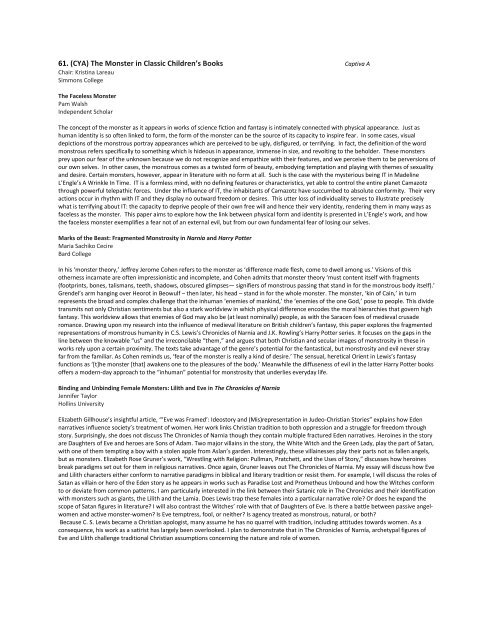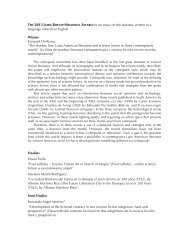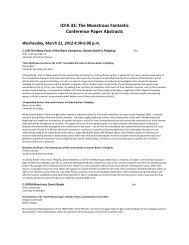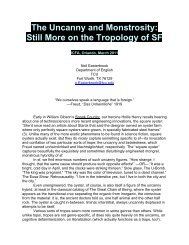61. (CYA) <strong>The</strong> Monster in Classic Children’s Books Captiva AChair: Kristina LareauSimmons College<strong>The</strong> Faceless MonsterPam WalshIndependent Scholar<strong>The</strong> concept of the monster as it appears in works of science fiction and fantasy is intimately connected with physical appearance. Just ashuman identity is so often linked to form, the form of the monster can be the source of its capacity to inspire fear. In some cases, visualdepictions of the monstrous portray appearances which are perceived to be ugly, disfigured, or terrifying. In fact, the definition of the wordmonstrous refers specifically to something which is hideous in appearance, immense in size, and revolting to the beholder. <strong>The</strong>se monstersprey upon our fear of the unknown because we do not recognize and empathize with their features, and we perceive them to be perversions ofour own selves. In other cases, the monstrous comes as a twisted form of beauty, embodying temptation and playing with themes of sexualityand desire. Certain monsters, however, appear in literature with no form at all. Such is the case with the mysterious being IT in MadelineL’Engle’s A Wrinkle In Time. IT is a formless mind, with no defining features or characteristics, yet able to control the entire planet Camazotzthrough powerful telepathic forces. Under the influence of IT, the inhabitants of Camazotz have succumbed to absolute conformity. <strong>The</strong>ir veryactions occur in rhythm with IT and they display no outward freedom or desires. This utter loss of individuality serves to illustrate preciselywhat is terrifying about IT: the capacity to deprive people of their own free will and hence their very identity, rendering them in many ways asfaceless as the monster. This paper aims to explore how the link between physical form and identity is presented in L’Engle’s work, and howthe faceless monster exemplifies a fear not of an external evil, but from our own fundamental fear of losing our selves.Marks of the Beast: Fragmented Monstrosity in Narnia and Harry PotterMaria Sachiko CecireBard CollegeIn his ‘monster theory,’ Jeffrey Jerome Cohen refers to the monster as ‘difference made flesh, come to dwell among us.’ Visions of thisotherness incarnate are often impressionistic and incomplete, and Cohen admits that monster theory ‘must content itself with fragments(footprints, bones, talismans, teeth, shadows, obscured glimpses— signifiers of monstrous passing that stand in for the monstrous body itself).’Grendel’s arm hanging over Heorot in Beowulf – then later, his head – stand in for the whole monster. <strong>The</strong> monster, ‘kin of Cain,’ in turnrepresents the broad and complex challenge that the inhuman ‘enemies of mankind,’ the ‘enemies of the one God,’ pose to people. This dividetransmits not only Christian sentiments but also a stark worldview in which physical difference encodes the moral hierarchies that govern highfantasy. This worldview allows that enemies of God may also be (at least nominally) people, as with the Saracen foes of medieval crusaderomance. Drawing upon my research into the influence of medieval literature on British children’s fantasy, this paper explores the fragmentedrepresentations of monstrous humanity in C.S. Lewis’s Chronicles of Narnia and J.K. Rowling’s Harry Potter series. It focuses on the gaps in theline between the knowable “us” and the irreconcilable “them,” and argues that both Christian and secular images of monstrosity in these inworks rely upon a certain proximity. <strong>The</strong> texts take advantage of the genre’s potential for the fantastical, but monstrosity and evil never strayfar from the familiar. As Cohen reminds us, ‘fear of the monster is really a kind of desire.’ <strong>The</strong> sensual, heretical Orient in Lewis’s fantasyfunctions as ‘[t]he monster [that] awakens one to the pleasures of the body.’ Meanwhile the diffuseness of evil in the latter Harry Potter booksoffers a modern-day approach to the “inhuman” potential for monstrosity that underlies everyday life.Binding and Unbinding Female Monsters: Lilith and Eve in <strong>The</strong> Chronicles of NarniaJennifer TaylorHollins UniversityElizabeth Gillhouse’s insightful article, “’Eve was Framed’: Ideostory and (Mis)representation in Judeo-Christian Stories” explains how Edennarratives influence society’s treatment of women. Her work links Christian tradition to both oppression and a struggle for freedom throughstory. Surprisingly, she does not discuss <strong>The</strong> Chronicles of Narnia though they contain multiple fractured Eden narratives. Heroines in the storyare Daughters of Eve and heroes are Sons of Adam. Two major villains in the story, the White Witch and the Green Lady, play the part of Satan,with one of them tempting a boy with a stolen apple from Aslan’s garden. Interestingly, these villainesses play their parts not as fallen angels,but as monsters. Elizabeth Rose Gruner’s work, “Wrestling with Religion: Pullman, Pratchett, and the Uses of Story,” discusses how heroinesbreak paradigms set out for them in religious narratives. Once again, Gruner leaves out <strong>The</strong> Chronicles of Narnia. My essay will discuss how Eveand Lilith characters either conform to narrative paradigms in biblical and literary tradition or resist them. For example, I will discuss the roles ofSatan as villain or hero of the Eden story as he appears in works such as Paradise Lost and Prometheus Unbound and how the Witches conformto or deviate from common patterns. I am particularly interested in the link between their Satanic role in <strong>The</strong> Chronicles and their identificationwith monsters such as giants, the Lilith and the Lamia. Does Lewis trap these females into a particular narrative role? Or does he expand thescope of Satan figures in literature? I will also contrast the Witches’ role with that of Daughters of Eve. Is there a battle between passive angelwomenand active monster-women? Is Eve temptress, fool, or neither? Is agency treated as monstrous, natural, or both?Because C. S. Lewis became a Christian apologist, many assume he has no quarrel with tradition, including attitudes towards women. As aconsequence, his work as a satirist has largely been overlooked. I plan to demonstrate that in <strong>The</strong> Chronicles of Narnia, archetypal figures ofEve and Lilith challenge traditional Christian assumptions concerning the nature and role of women.
62. (F) <strong>The</strong> Works of Tolkien Captiva BChair: W. A. SeniorBroward CollegeOf Spiders and ElvesJoyce Tally LionaronsUrsinus CollegeIn J.R.R. Tolkien's <strong>The</strong> Two Towers, the ent Treebeard tells Merry and Pippin that orcs were made by Sauron in mockery of elves and trolls inmockery of ents. A closer look at Tolkien's novels, however, would indicate that the evil race corresponding to the elves is not the orcs, butrather the giant spiders who inhabit the parts of Mirkwood that border the land of the wood-elves, and whose progenitor lurks in Cirith Ungolon the borders of Mordor. Although several scholars (notably Anne C. Petty and Peter Goselin; see bibliography) have noted and explored thebinary relationship between Galadriel, queen of the elves in Lothlorien, and Shelob, mother of the spiders, none have developed theirarguments to deal with the elven and arachnid races as a whole. This paper will examine Tolkien's complex web of correspondences betweenelves and spiders in <strong>The</strong> Hobbit and <strong>The</strong> Lord of the Rings to show that these associative characteristics underlie his construction of the feminineand sexuality in both books, and that they in turn prepare for and make possible the crowning obverse of Tolkien's two archetypes offemininity, Galadriel and Shelob.<strong>The</strong> Ring as Protagonist: <strong>The</strong> Instigating Power of the Ring in J. R. R. Tolkien’s <strong>The</strong> HobbitMatthew DeAngelisCollege of CharlestonThis paper discusses the narrative qualities of Tolkien’s <strong>The</strong> Hobbit, focusing on Bilbo’s heroic journey. I attempt to dissuade this point as theprimary theme of <strong>The</strong> Hobbit, arguing instead for the Ring to be the primary protagonist of the story. <strong>The</strong> paper compares scenes before andafter the Ring’s finding, analyzing Bilbo’s actions. Also, the chapter “Riddles in the Dark” is examined in great detail as to Tolkien’s views ofpower as a detractor to society. <strong>The</strong> essay sums up by taking a deeper look at the Battle of Five Armies, revealing Bilbo to potentially workingfor evil without even knowing it, indicating the Ring’s treacherous intentions rather than shrouding Bilbo in glory. <strong>The</strong> final point is how thebecause of the blatant power of the Ring in <strong>The</strong> Hobbit, the metafictive element of the narrative can be questioned. As Tolkien revised the earlyedition of <strong>The</strong> Hobbit, so too did he claim Bilbo’s version to have been corrupted by the Ring, particularly the treating of Gollum. With thisinterpretation it is possible that <strong>The</strong> Hobbit is a novel wrought by and of the Ring. While accepting Bilbo to be a hero, the paper takes issuewith the emphasis of a number of previous critics. While Bilbo is the hero, he can only complete his journey with the Ring. Tom Shippey evencalls the Ring a ‘trinket’ which is a major disservice to the object, which truly takes on vital importance to the narrative both in garnering Bilborespect, as well as establishing a hero.Tolkien’s “Great Saga”: A “Long Defeat” without a “Final Victory”Elizabeth Whittingham<strong>The</strong> College at Brockport - SUNYAlthough the tale of Beren and Lúthien has received much attention and is closely associated with Tolkien's own life, the tales about Húrin andhis children came to be the author’s “Great Saga” (Jewels 1994, x). Christopher’s description of his father’s writing process in regards to thistale is true of most of his stories about Middle-earth: “the story grew and changed as he wrote . . .” (Jewels 1994, 260). <strong>The</strong> tale of TúrinTurambar, which involves all the members of his family and their individual deeds and experiences, is a good example of the evolution of manyof Tolkien's works over nearly six decades of writing and revision. In Turambar and the Foalókë from <strong>The</strong> Book of Lost Tales II, Tolkien usesmany names that appear in different forms in later versions as his stories and languages evolve: <strong>The</strong> tale is told by Eltas in the framework of thestorytelling of the first two volumes, and some elements of the later versions are missing. A few elements of the tale apparently exist from thebeginning, but one of the most unusual aspects of this early version is in the final paragraph, which explains that Úrin and Mavwin intercede fortheir children and the “Gods had mercy on their unhappy fate”: “those twain Túrin and Nienóri entered into Fôs’Almir, the bath of flame . . .and so were all their sorrows and stains washed away” (Lost Tales II 1984, 115-16). Not only are they purified, but the text also states, “theydwelt as shining Valar among the blessed ones . . .” (Lost Tales II 1984, 116). <strong>The</strong> idea of two humans living as Valar is unbelievable andinconsistent with the metaphysics of Middle-earth, so it is not surprising that it disappears from the tale in the very next telling. Also averred inthe tale’s last paragraph is Túrin’s role in what is later referred to as the Last Battle: “Turambar indeed shall stand beside Fionwë in the GreatWrack, and Melko and his drakes shall curse the sword of Mormakil” (Lost Tales II 1984, 116). Some version of this final role for Túrin survivesuntil the late 1950s. <strong>The</strong> next version of the story is in verse form. Although Tolkien wrote many poems about Middle-earth, only the tales ofTúrin Turambar and of Beren and Lúthien are developed into lengthy works, which are contained in <strong>The</strong> Lays of Beleriand, volume three of theHistory of Middle-earth. As a scholar of medieval literature, Tolkien had a special appreciation for alliterative verse and chose that form torelate the earliest elements of Túrin’s tale. <strong>The</strong> poem begins with the capture of Húrin and only in this work is the conversation between Húrinand Melko/Morgoth recounted in any detail, a powerful moment. <strong>The</strong> two versions of the poem cover little of the story, and the poems breakoff before the appearance of the dragon, the events involving Níniel, and the tale’s tragic ending. <strong>The</strong> early 1930’s Quenta Noldorinwa, from<strong>The</strong> Shaping of Middle-earth, is only about a third as long as Turambar and the Foalókë. In this later text, Mîm the Dwarf appears, though hisrole is quite limited in comparison to its final form in the 1977 Silmarillion. <strong>The</strong> Quenta Silmarillion from the late 1930s, the last version of theSilmarillion before Tolkien set it aside to work on <strong>The</strong> Lord of the Rings, breaks off at the point at which Túrin flees from Menegroth andbecomes an outlaw, and many tales from the end of the First Age are omitted. <strong>The</strong> final section picks up with Eärendel’s appeal to the Valar,the subsequent battle against Morgoth at the end of the First Age, and the prophecy concerning the Last Battle at the End of Days, which stillmentions Túrin’s triumphant return and places Túrin “among the sons of the Valar” (Lost Road 1987, 333). Tolkien picks up the story again inthe early 1950s in <strong>The</strong> Grey Annals., but more significantly, in <strong>The</strong> War of the Jewels, the story of Húrin and Túrin develops further and morefully in <strong>The</strong> Wanderings of Húrin and in Ælwine and Dírhaval. <strong>The</strong> Tale of Years also changes and adds to some aspects of the story. Túrin’s tale
- Page 4 and 5: 5. (F) Wondrous Bodies of the Gende
- Page 6 and 7: Fantastic Suicide: Reading the Unca
- Page 8: Viral Posthumanism: Boundaries and
- Page 11 and 12: The Concept of Soul Divisibility in
- Page 13 and 14: Thursday, March 22, 2012 10:30 a.m.
- Page 15 and 16: 21. (CYA) Terrifying Futures: Post-
- Page 17 and 18: 23. (FTV/H) Now I’m Feelin’ Zom
- Page 19 and 20: Fight Club: Amalgam of the Horrific
- Page 21 and 22: Taking the Monsters out of the Clos
- Page 23 and 24: Kaspar J. SaxenaIndependent Scholar
- Page 25 and 26: 44. (CYA) The Monstrosity of Teenag
- Page 27 and 28: 46. (FTV/SF) Monstrous Spin-offs: T
- Page 29 and 30: 49. (F) Aspects of Miéville Captiv
- Page 31 and 32: 53. (SF) War and Crisis in 1940s an
- Page 33 and 34: Abuse of Power: An Evolutionary Res
- Page 35 and 36: Disappearing Natives: The Colonized
- Page 37: 60. (H/IF) Ancient and Medieval Mon
- Page 41 and 42: 67. (SF) Imperial and Postcolonial
- Page 43 and 44: Beheading the Gorgon: Beautifying C
- Page 45 and 46: 71. (VPA) Monstrous Music MagnoliaC
- Page 47 and 48: 73. (F/IF) Portraying New Worlds Ca
- Page 49 and 50: Friday, March 23, 2012 2:45-3:45 pm
- Page 51 and 52: 81. (FTV) Those Damn Dirty Apes! Cy
- Page 53 and 54: Friday, March 23, 2012 4:00-5:30 pm
- Page 55 and 56: 92. (F) Leaving the Demonized Other
- Page 57 and 58: 94. (FTV/CYA) Monstrosity and Devia
- Page 59 and 60: of cannibalism, ghostly seduction i
- Page 61 and 62: Saturday March 24, 2012 8:30-10:00
- Page 63 and 64: 104. (CYA) Classic Monsters, Reinte
- Page 65 and 66: 107. (VPA) Monstrous Gaming Bodies
- Page 67 and 68: who challenge the order that the Br
- Page 69 and 70: Reading Between the Times: A Critic
- Page 71 and 72: 117. (FTV) Monsters and Superheroes
- Page 73 and 74: 119. (IF/H/PCS) International Mash-
- Page 75 and 76: Focusing on Stoker's Dracula as one
- Page 77 and 78: Florida Atlantic UniversitySheri S.
- Page 79 and 80: Simmons CollegeIn the spate of rece
- Page 81 and 82: Independent ScholarKing’s story
- Page 83 and 84: modernity opens up for every indivi
- Page 85 and 86: Saturday March 24, 2012 4:00-5:30 p
- Page 87 and 88: 141. (FTV) Monstrous Masculinity Cy
- Page 89 and 90:
ultimately make peace with her mons
- Page 91 and 92:
where the almost-human sentient zom





